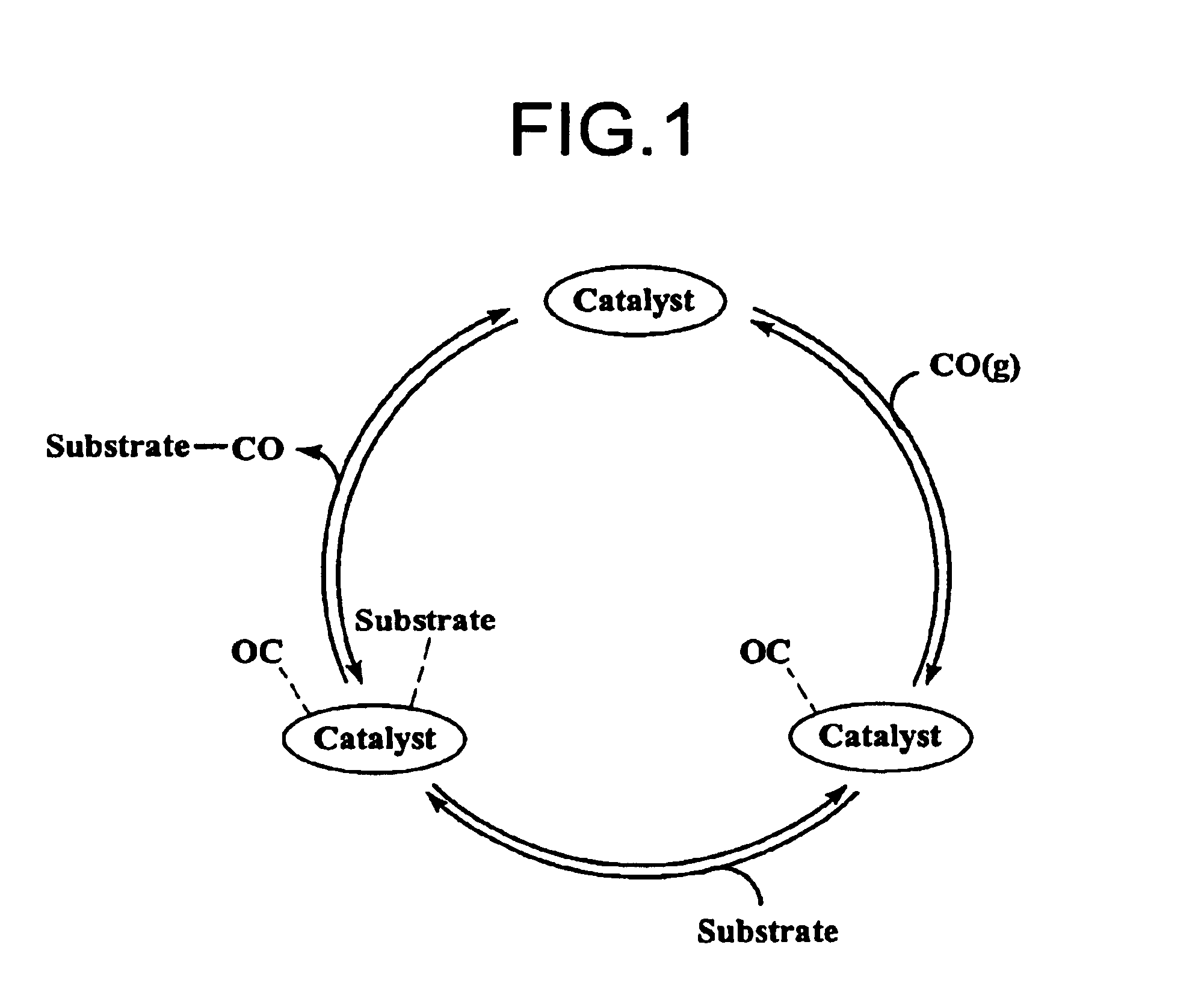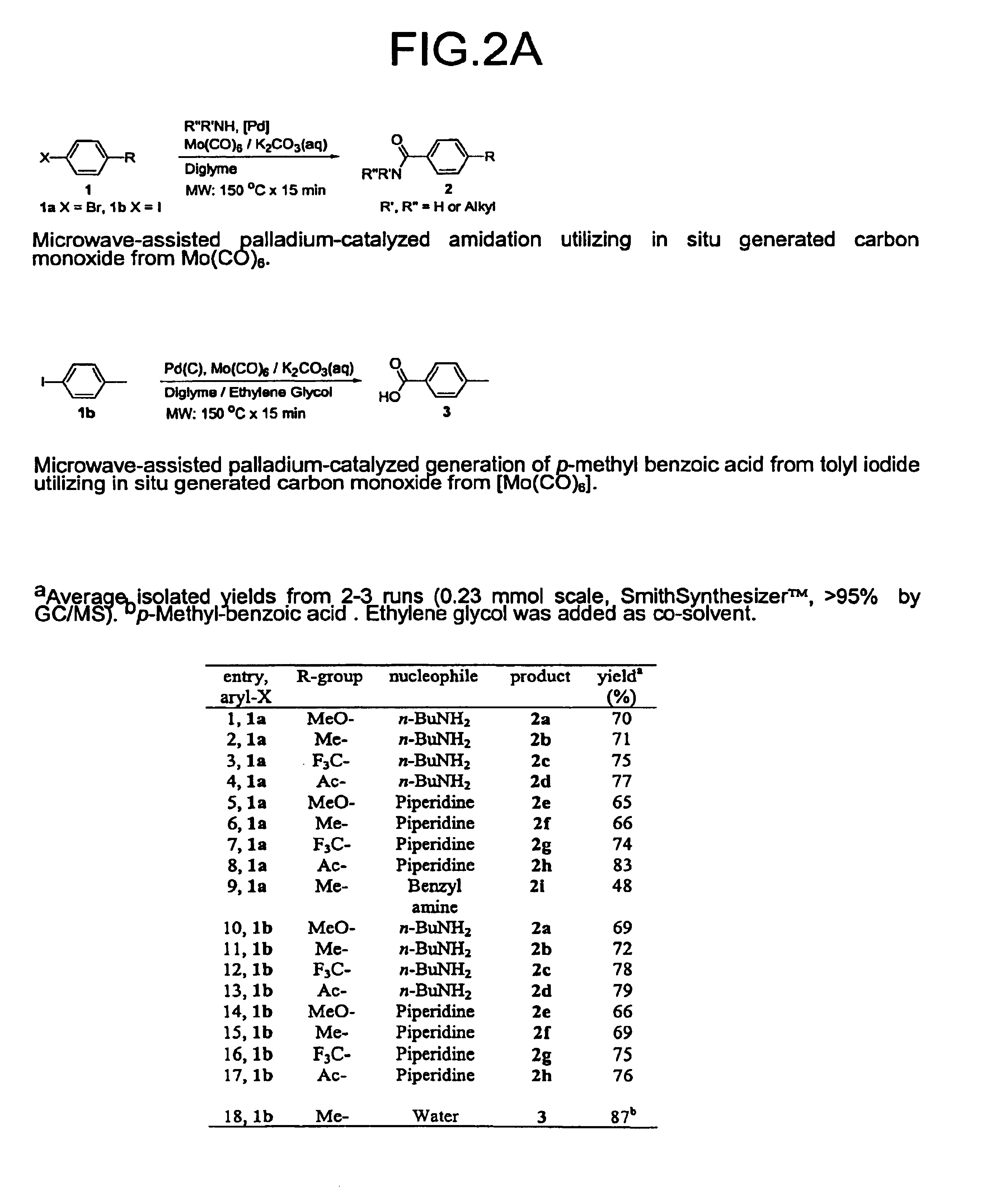Organic reactions with CO generating materials
a technology of organic reactions and co-generating materials, applied in the preparation of carbonyl compounds, instruments, organic chemistry, etc., can solve the problems of inefficient catalysts, extremely toxic nickel carbonyl, and use of external pressure of carbon monoxide gas, and achieve the effect of improving the catalyst efficiency and reducing the cost of production
- Summary
- Abstract
- Description
- Claims
- Application Information
AI Technical Summary
Problems solved by technology
Method used
Image
Examples
examples 1-2
Type I: Carbonylation
[0116]The reactions and the results of Examples 1 and 2 are shown in FIG. 2.
[0117]General Microwave Procedure for the Synthesis of Amides 2. [Mo(CO)6] (30.0 mg, 0.114 mmol) and 1.375 mL of a fresh toluene solution of palladacycle (8.0 mg, 8.5 μmol) and BINAP (14.0 mg, 22.0 μmol), were charged into a Smith Process Vial (a microwave-tube). A teflon-coated stirring bar was added. Utilizing the SmithSynthesizer 0.200 mL 4.0 M K2CO3(aq), 1.00 mL diglyme, 0.290 mmol amine and aryl halide (0.229 mmol, 0.100 mL of a stock solution of 4.59 mmol aryl halide in 2.00 mL diglyme) were dispensed into the microwave tube. The tube was sealed (Crymper-seal) and the mixture was heated by microwaves at 150° C. for 15 minutes. The mixture turned black during irradiation. After cooling, the reaction mixture was filtrated and concentrated at reduced pressure. The amide 2 was isolated by flash-chromatography.
[0118]Instead of the palladacycle and BINAP combination, corresponding amount...
example 3
[0121]The reaction of Example 3 is shown in FIG. 3.
Type III: Hydroformylation
[0122]Mo(CO)6 (30 mg, 0.11 mmol), NaH (60%, 16 mg, 0.40 mmol) and Wilkinsons catalyst (10 mg, 11 μmol) were measured into a Smith Processing Vial™ microwave-tube. A teflon-coated stirring bar was added. Utilising the Smith Synthesizer™ styrene (36 ml, 0.31 mmol), 1.200 mL Diglyme and 0.400 mL Ethylene glycol were dispensed into the microwave tube. The tube was sealed (Crymper™-seal). The mixture was subjected to microwaves so that the temperature was 170° C. for 8 minutes. The mixture then turned black. 2 mL of water and 3 mL of ether was added using the Smith Synthesizer™ dispenser. The mixture was shaken and filtrated. Analysis was performed by GC-MS.
examples 4-9
[0123]The results and products of Examples 4-9 are shown in FIGS. 4 and 5.
Type I: Carbonylation of Aryl iodides
[0124]General Microwave Procedure for the Synthesis of Esters 3.
[0125]A SmithProcessingVial™ with a teflon coated stirrer bar was charged with molybdenum hexacarbonyl (33 mg, 0.125 mmol) and palladium on charcoal (12.5 mg, 10% Pd / C). Diglyme (500 μL), diisopropylethylamine (185 μL, 1.0 mmol), alcohol 2 (500 μL, 3.5-6.7 mmol) and aryliodide 1 (0.25 mmol) were thereafter added. The vial was sealed with a Crymper™ seal and the reaction system was mixed manually to a suspension. The reaction was heated by microwave irradiation to 160° C. for 15 min (3a, 3b 5 min) with a Smith Synthesizer™. After cooling, the reaction mixture was evaporated and filtered through a short silica plug with dichloromethane as eluent. Analysis was performed by GC-MS and 1H-NMR. The isolated products 3 were >95% pure by capillary GC-MS.
Formamide of the General Formula HCONR1R2 (II) as CO Generating Com...
PUM
| Property | Measurement | Unit |
|---|---|---|
| temperature | aaaaa | aaaaa |
| temperature | aaaaa | aaaaa |
| temperature | aaaaa | aaaaa |
Abstract
Description
Claims
Application Information
 Login to View More
Login to View More - R&D
- Intellectual Property
- Life Sciences
- Materials
- Tech Scout
- Unparalleled Data Quality
- Higher Quality Content
- 60% Fewer Hallucinations
Browse by: Latest US Patents, China's latest patents, Technical Efficacy Thesaurus, Application Domain, Technology Topic, Popular Technical Reports.
© 2025 PatSnap. All rights reserved.Legal|Privacy policy|Modern Slavery Act Transparency Statement|Sitemap|About US| Contact US: help@patsnap.com



